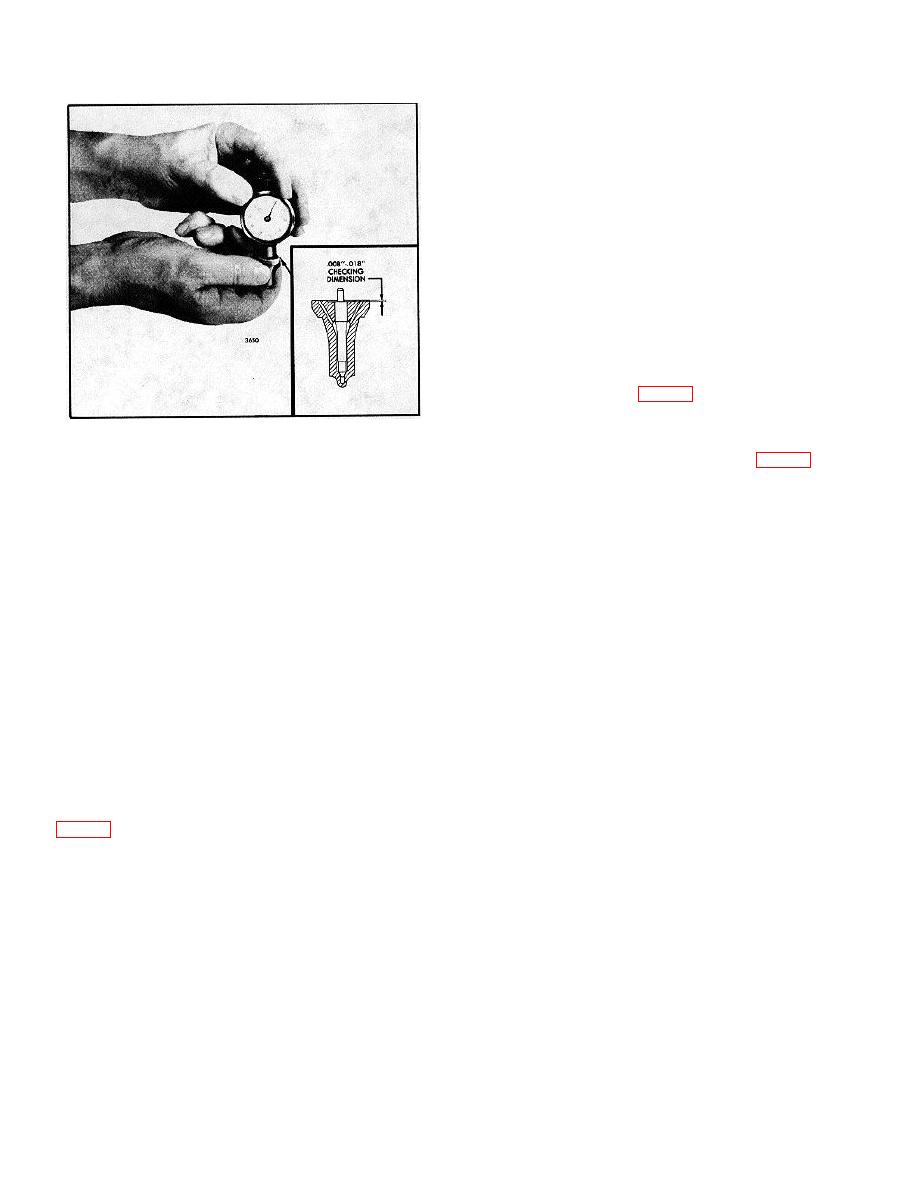
TM 5-3895-359-14&P
it is less than .018", inspect for foreign material between
the needle valve and the tip seat.
Meat
4. If the needle valve lift is within limits, install a new
needle valve spring and recheck the valve opening
pressure and valve action. Low valve opening pressure or
poor atomization with a new spring and seat indicates the
spray tip and needle valve assembly should be replaced.
5. Reassemble the injector as outlined under Assemble
Injector and check the injector output with calibrator J
22410.
Needle Valve Tip Test (Using Auxiliary Tester J 22640)
1. Connect the pipe from auxiliary tester J 22640 to the
rear of the J 23010 tester at the connection located near
the bottom of the tester (Fig. 17).
2. Assemble cleaned injector parts, including the check
Fig. 16. Checking Needle Valve Lift
valve cage, spring, spring seat, spring cage and spray tip
3300 psi (15 158 and 22 737 kPa). The opening and
assembly, on the auxiliary tester J 22640 (Fig. 18).
closing action should be sharp and produce a normal,
3. Carefully pilot the injector nut over the spray tip and
finely atomized spray pattern.
valve parts and thread it on the auxiliary tester.
If the valve opening pressure is below 2200 psi (15 158
4. Tighten the injector nut.
kPa) and/or atomization is poor, the cause is usually a
weak valve spring or a poor needle valve seat.
5. Open the valve on the auxiliary tester and place lever
4 in the up (horizontal) position.
If the valve opening pressure is within 2200-3300 psi (15
158-22 737 kPa), proceed to check for spray tip leakage
6. Install the shield on the auxiliary tester and operate
as follows:
pump lever 1 until the needle valve has opened several
times to purge the air from the system.
a. Actuate pump lever 1 several times and hold
the pressure at 1500 psi (10 335 kPa) for 15
7. Operate pump lever 1 rapidly with smooth even strokes
seconds.
(40 strokes per minute) simulating the action of the tip
b. Inspect the spray tip for leakage. There should
functioning in the engine. Note the pressure at which the
be no fuel droplets, although a slight wetting at
test oil delivery occurs. Test oil delivery should occur
the spray tip is permissable.
between 2200 and 3300 psi (15 158 and 22 737 kPa).
The beginning and ending of delivery should be sharp and
Needle Valve Lift Test
the test oil should be a finely atomized spray.
To measure the needle valve lift, use tool J 9462-02
If the valve opening pressure is below 2200 psi (15 158
(Fig. 16) as follows:
kPa) and/or atomization is poor, the cause is usually a
weak valve spring or poor needle valve seat.
1. Zero the indicator by placing the bottom surface of
the plunger assembly on a flat surface and zero the
If the valve opening pressure is within 2200-3300 psi (15
indicator dial.
158-22 737 kPa), proceed to check for spray tip leakage
as follows:
2. Place the spray tip and needle valve assembly tight
against the bottom of the gage with the quill of the
a. Actuate the pump lever several times and hold the
needle valve in the hole in the plunger.
pressure at 1500 psi (10 335 kPa) for 15 seconds.
3. While holding the spray tip and needle valve
assembly tight against the gage, read the needle valve
b. Inspect the spray tip for leakage. There should be
lift on the indicator. The lift should be .008 " to .018 ". If
it exceeds .018 ", the tip assembly must be replaced. If
10-3-11


